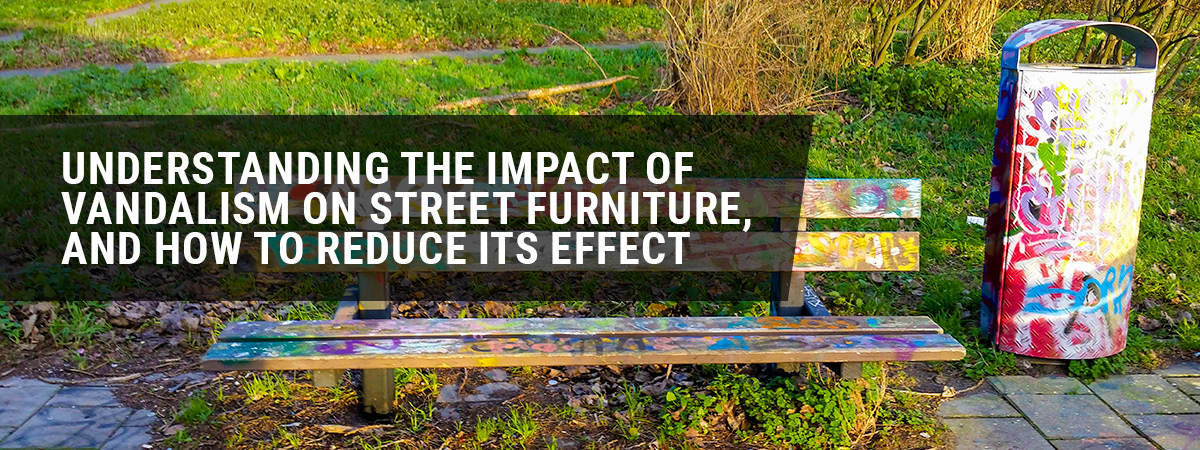Understanding the impact of vandalism on street furniture, and how to reduce its effect

Street furniture is increasingly influencing our urban environments, adding aesthetic value and functional improvements with well thought out seating, litter bins, tree protection, planters, bollards, cycle parking and shelters.
As a sub-contractor, you play a critical role in planning and installing street furniture, ensuring towns and cities look the part, that they are functional and help pedestrians move around safely, as well as fulfilling residents’ needs to help socialise and connect with each other.
However, there's a lurking challenge that many in the industry face - vandalism.
Vandalism - more than just a cosmetic issue
At first glance, acts of vandalism, like graffiti or petty damage, may seem like minor aesthetic annoyances for site owners and local councils. However, their impact runs deeper.
Firstly, the economic drain it poses where vandalised furniture pieces will require cleaning, repair or complete replacement. These unforeseen costs have to be absorbed by businesses, land owners and councils and can often strain budgets.
Vandalised street furniture can also degrade the appeal of an urban space, as it is unsightly and not fit for purpose. Residents and visitors may perceive the area as unsafe or neglected, affecting local businesses and tourism. It may also compromise safety for pedestrians and nearby people, particularly damaged street furniture items with sharp edges.
Finally, there is an environmental cost in replacing and fixing damaged street furniture, among sub-contractors. It requires more resources such as travel and work on site, increasing the carbon footprint of a street furniture installation.
What can be done to minimise vandalism on
street furniture?
There are ways to reduce any potential vandalism on street furniture, which can be easily implemented by sub-contractors, including:
Choosing durable street furniture - Using street furniture crafted from materials resistant to scratches, dents, and graffiti can enhance the lifespan of street furniture.
Examples include stainless steel, high-density polyethylene (HDPE), and certain anti-graffiti finishes.
Use street furniture that has modern designs - By installing street furniture products that have rounded surfaces or ones that are designed with fewer crevices, it reduces the potential of the furniture being damaged.
The reason is rounded surfaces are more difficult to graffiti, and furniture with fewer gaps or crevices prevent vandals either forcing them open.
Strategic placement - Positioning street furniture in well-lit, high-traffic areas can deter potential vandals.
Involve the community - Encouraging community ownership and pride is a great, cost-effective way to reduce vandalism.
Sub-contractors and installers can do this during the installation process by talking to nearby pedestrians and the local community, telling them about the furniture and the wider project and the benefits they will bring to the local area.
This makes it more likely they will take ownership and accountability of the furniture, and less tolerant to any anti-social behaviour towards the street furniture.
Quick response to vandalism - Finally, a policy of a rapid response to any vandalism from specialist sub-contractors or maintenance contractors can discourage repeat offences. This can be in the form of cleaning, repairing or replacing vandalised furniture pieces.
The longer street furniture pieces are left with clear signs of vandalism, the more likely they are to be an increased target and incur further vandalism.
The impact of vandalism on street furniture, and how to minimalise its effects
While vandalism’s impact on street furniture is undeniable, sub-contractors can work with street furniture manufacturers to effectively curb its effects.
Suppliers and manufacturers have a duty to offer street furniture with short lead times (to help with the response time to vandalised furniture); high quality furniture products that resist or certainly reduce the potential of vandalism; street furniture that is aesthetically pleasing which will promote more ownership and pride with local residents; as well as a responsive and technically competent sales team to assist with product selection.
If you would like more information on how our range of street furniture can benefit your project by potentially reducing the effects of vandalism, feel free to contact our team who will be happy to help.
You can telephone us on 01625 879 442 or
email us at enquiries@streetfurnituredirect.co.uk,
and we will be happy to talk through the best options for you.